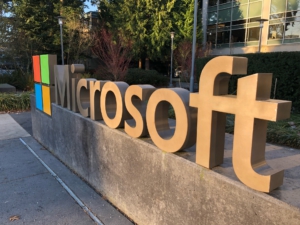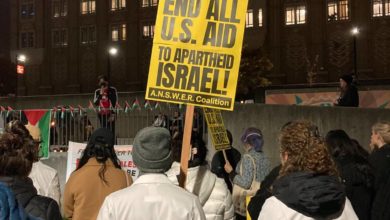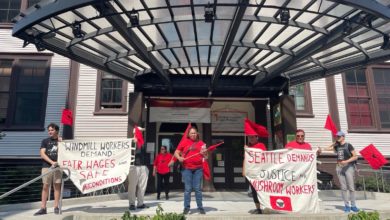On January 17, Microsoft announced it would commit $500 million for affordable housing in the Seattle metropolitan area. The funding will focus on increasing affordable housing in Seattle’s Eastside suburbs, near the tech giant’s main campus in Redmond. Microsoft plans to disburse these funds over the next three years, with a small portion also committed to addressing homelessness in the greater Seattle metropolitan area. Pundits in the bourgeois media have already started hailing Microsoft for its supposed generosity. King County Executive Dow Constantine even called the investment “historic for our region.
Most of this money will be loans to developers to build so-called affordable housing units. Some $225 million in below-market interest loans will be made available to developers to build units aimed at households with $62,000 to $124,000 annual income–families hardly living in poverty. An additional $250 million in market rate loans will be extended to build housing for households with less than $48,150 annual income. So, $475 million of the earmarked funds will eventually be paid back to Microsoft–with interest.”
The final $25 million are grants to services for low-income and homeless residents in the Seattle metropolitan area, including $5 million of funding for an existing joint effort between the United Way, the King County Bar Association,and the Seattle Mariners for a legal clinic for tenants facing eviction. Another $5 million of Microsoft’s spending on homelessness will support the ongoing merger of County and Seattle city homelessness services. Seattle and King County currently spend a combined $205 million annually on homeless services with $115 million coming from the county budget and $90 million from the city.
Microsoft has this kind of money laying around due to its significant annual net income and cash reserves. In the past decade, the company has racked up $184 billion in net income. The company’s plan, which has already generated a significant amount of positive press, just 2.7 percent of its annual net income. This $500 million housing initiative represents a one-time 31 percent increase in the company’s advertising budget.
A drop in the bucket
How much affordable housing can $500 million buy? Unfortunately, not much under the status quo. If that money was invested in a single project in a west coast high tech city like Seattle or San Francisco, it would result in just about 1,000 additional units of affordable housing which is much less than the very optimistic “tens of thousands” of units Microsoft has touted it will build. According to Microsoft’s own analysis, King County will need over 300,000 more affordable housing units over the next 2 decades. An additional 14,000 units are needed right now to house the county’s homeless population.
Microsoft’s announcement marks the first time a major tech company has weighed in on the housing crisis in Seattle since Amazon pressured the Seattle City Council to overturn its unanimous passage of the employee hours tax in 2018, which would have generated nearly $50 million annually for affordable housing by taxing companies with annual revenues of over $20 million at a rate of roughly $275 per employee.
Microsoft President and Chief Legal Officer Bradford Smith repeatedly cited the need for teachers, nurses and firefighters to have access to affordable housing, leaving other workers to wonder where that leaves them if they don’t fit into these categories. In addition to workers who provide socially necessary services, Microsoft needs to maintain a labor pool of technically skilled professionals, so investing in affordable housing in its own backyard for the upper sectors of the working class is in the company’s best interest. More affordable housing in Redmond will help with the recruitment and retention of skilled tech employees who might otherwise go to Apple, Google, Facebook, or Amazon. Thus 95 percent of these funds are earmarked for use in areas immediately surrounding Microsoft’s Redmond campus, where many of their employees would like to live.
It’s noteworthy that Smith shared the stage at the press conference with King County Executive Dow Constantine, to whose re-election campaign Smith personally donated $1,125 in 2017, in addition to Microsoft’s donation of $1,900 and a $500 per plate fundraiser for Constantine, hosted by Smith and Microsoft. For his part, Constantine was effusive in his praise for Microsoft, calling it a “historic moment for our region” while floating the possibility of “making available surplus property, streamlining permitting, or providing incentives to encourage development.” Also on stage was Seattle Mayor Jenny Durkan, who received $500 from Smith in her 2017 mayoral campaign, along with a total of $8,270 from Microsoft employees.
That 95 percent of Microsoft’s spending is limited to the Eastside suburbs of Seattle, where most of the company’s offices are located, reflects a larger trend among large tech corporations. When they do decide to address the issue of housing, their response has been confined to the areas immediately surrounding their headquarters, as was the case with Google in Mountain View and Facebook in Palo Alto. Microsoft’s plan to target only the suburban areas in the eastern portion of King County and the southern portion of Snohomish County means the ongoing housing crisis within the Seattle city limits will be almost completely unaddressed by these funds.
Ultimately, capitalism is ill-equipped to address the problems that it creates. Because capitalist society prioritizes private profits over public welfare, it will inevitably fail to meet the material needs of the people. Only a society that centers the needs of people over corporate profits can adequately meet the housing needs of all its members.







